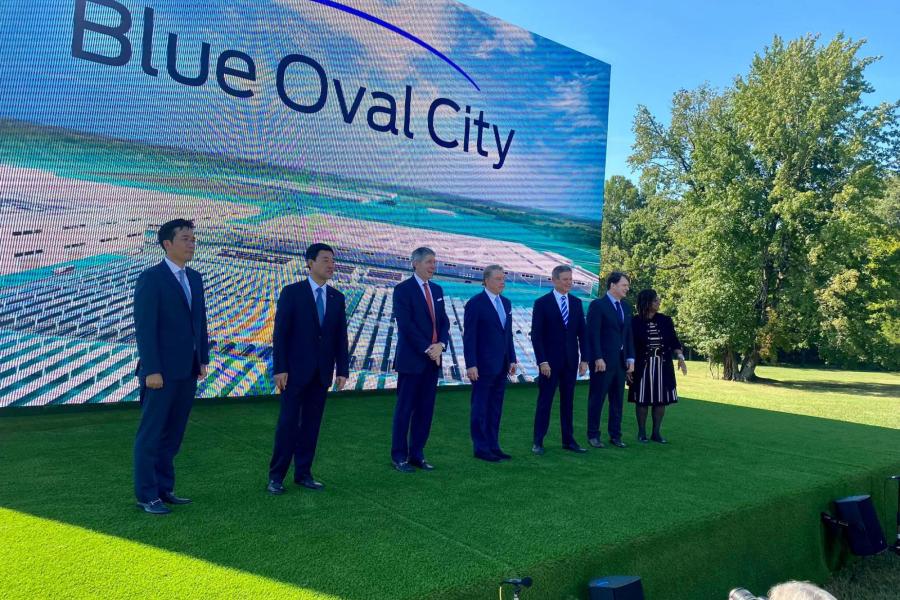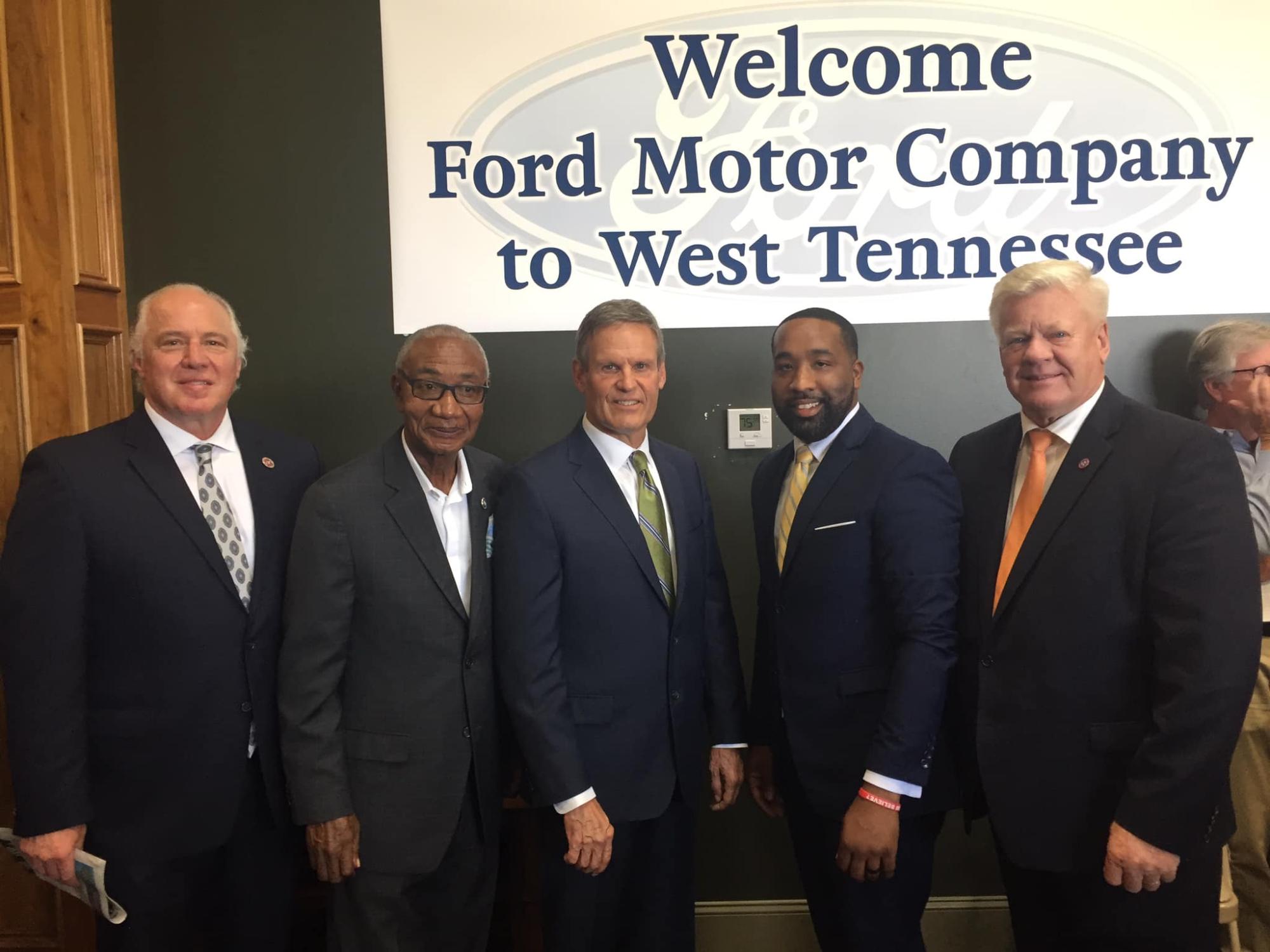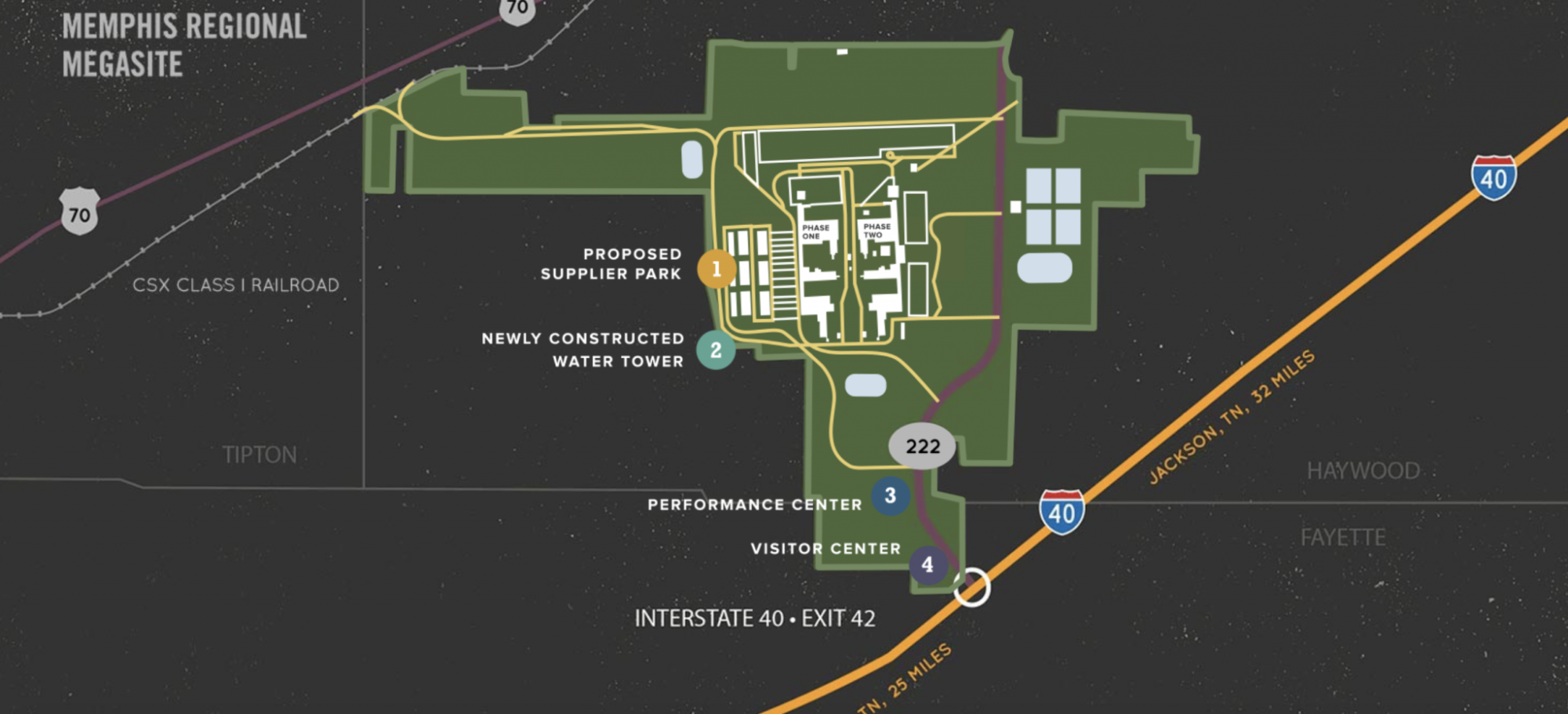State officials host first Blue Oval City Community Impact Meeting

By KATE COIL
TML Communications Specialist
Meeting regional water and wastewater needs, particularly through use of federal ARPA funds, was the topic of discussion for the first Blue Oval City Community Impact meeting hosted by the Tennessee Department of Economic and Community Development (TNECD).
Officials with the Tennessee Department of Environment and Conservation (TDEC) presented information on how municipalities can best begin to prepare their water and wastewater infrastructure for the growth anticipated as a result of the Blue Oval City development. Tennessee Commissioner of Environment and Conservation David Salyers said the project presents a major opportunity.
“This is such an exciting time for our state and especially for West Tennessee,” he said. “I feel like that dog who was chasing the car all along trying to land that big project at the megasite. Now, we’ve caught that car, and it happens to be an electric Ford F-150 Lightning. I think we are going to have a lot of challenges going forward, but I know the mayors out there and how well they work together. We are going to get this done.”
Brooxie Carlton, assistant commissioner of community and rural development with TNECD, noted that officials throughout West Tennessee have been eager for information and to get started on their own planning and development necessary to build the framework for Blue Oval City.
“Nobody thought about what happens when we land something at the megasite,” Carlton said. “We were so focused on landing something at the megasite that we didn’t focus on what happens after that. We were behind the curve, I would say. It has taken us a minute to get caught up, but my vision for these meetings is to get everyone on the same page, make sure they’re up-to-speed, feel comfortable knowing what is going on at Blue Oval City and around Blue Oval City, and make sure they have the resources that they need to deal with how this is going to impact their communities.”
Cartlon said the second major topic of conversation she has seen regarding the development is about what water and wastewater infrastructure needs should be met. As a result, TDEC was asked to talk on the topic for the first meeting.
Greg Young, deputy commissioner for TDEC’s Bureau of Environment, said planning ahead will help find the best funds for necessary projects.
“People are going to want to jump directly to is building something,” Young said. “You can’t do that. What you really need to do is plan first. ECD is pushing folks to do comprehensive planning first. Bring on some folks at your level or the state level to do comprehensive land-use planning and within that overarching framework of land-use planning do water and wastewater planning. Get the framework down and then plug in that water/wastewater component to that. Through that, we believe that comprehensive planning and water/wastewater planning provides a more holistic, robust identification of those needs that will lead to more meaningful and impactful spends of those ARP dollars."
Important Links |
|---|
|
Carlton said while there is pressure to move ahead with ARPA funding, planning is essential to making sure projects go smoothly. ECD has money available to help with this process and ARPA funds can also be used for planning.

“Even if it is just starting with the TDEC Infrastructure Scorecard, we need to take a minute to do planning,” she said. “ECD has some planning funds to help communities impacted by Blue Oval City. Part of that will be water and sewer, part will be housing. We are putting out an RFP in the next few weeks for someone to provide those planning services to you guys through ECD. If we don’t take time to plan this out then 10 years from now you are going to be in the same situation with the same amount of infiltration and water loss, or we are going to have something built out and have regrets about how things were done.”
To help understand current status, condition, financial health, and physical health of infrastructure, Young recommended officials use the new Tennessee Infrastructure Scorecard. Vena Jones, environmental consultant with TDEC, said the scorecard is accessed through the ARPA site, the TDEC Revolving Fund website, and through the Tennessee Association of Utility Districts (TAUD) site.
Jones said all eligible projects being submitted to TDEC will need information from the scorecard, which was created in partnership between TAUD and TDEC. TAUD will be presenting workshops in February on completing the scorecard.
“It is a self-assessment for water infrastructure needs,” Jones said. “One of the critical needs identified is an asset-management plan. A capital improvement plan is included in that overall asset management plan. All systems that apply have to have a summary so we know you’ve identified your most critical needs and you have a proposal that is at least in part addressing them.”
Young said looking at the bigger picture may also help identify what funds are best used where.
“Something we have encouraged folks to do is to consider the bigger picture, the long-range plan,” he said. “Consider how ARP dollars that are coming down the pipeline quickly play into a bigger framework and can work with funds from CDBG, USDA Rural Development, SRF, and others. We have additional opportunities that may be coming down the pipe. As we are talking about water and wastewater infrastructure, we encourage folks to play the long-game and take the long view.”
Karen Simo, chief of staff for TDEC, said ARPA funds are a great opportunity for addressing the needs, but are not a “silver bullet.”
“As we are crafting ARPA and trying to strategically think about as a state how we can use it and how we can help local communities use it, we are also trying to put it in the context of all the other funding that is out there,” Simo said. “There is more money coming down from the feds after ARPA that is going to come through our SRF (State Revolving Fund) program. We realize each of these versions of funds had a different color and different requirements, which can be very difficult and challenging. We are also trying to push each fund toward its best use in light of what we know is available elsewhere.”

Young said gathering information on the front end will help communities move forward with projects and that TDEC has a website dedicated to helping with ARPA projects and guidelines as well as a disbursement plan for funds.
“We are collecting a lot of information,” he said. “We want you all to have a place that is a one-stop-shop from a TDEC aspect on what is going on and where you need to plug in. This website not only has a current of information you can use but opportunities to ask questions. We want to be able to respond to questions. The most efficient way – bar none – is to sign up on our email list. We have someone monitoring that 24/7.”
Starting with smaller projects will lay the groundwork for bigger future development.
“Inflow and infiltration and water loss are significant problems,” Young said. “The bang for the buck you can get by addressing those problems can be huge. Look for opportunities to develop projects around those problems first and then look to developing the brand-new shiny infrastructure. We need to take care of what we have first to maximize its functionality before we start doing new stuff. You may not need the fancy car when what is really needed is just some basic improvements. There is basic, short-term stuff that can be done on a different time frame than some of the long-term stuff.”
Collaboration will also be key to making sure infrastructure needs are met in the area.
“Communicate, coordinate, and collaborate,” Young said. “Develop regional ideas and approaches. Look for this regional-type, bigger and longer-term opportunities. We don’t need to reinvent the wheel. There are regional projects inside and outside of Tennessee that can serve as examples for some of your opportunities. Look at your existing legal options and frameworks. You may need to carry some legislation, and we can work with that.”

Regional collaboration can also help with obstacles these projects may encounter and may provide win-win situations for all those involved.
“There may be discharge limits into the Hatchie,” he said. “We need to see what the problems, limitations, and hurdles are at the outset so we can find ways to jump those hurdles. That is where the regional opportunities really help us. One we have seen already and want to be careful about in West Tennessee is some of the soils in West Tennessee are not optimal for sceptic or decentralized wastewater treatment systems. Don’t assume a quick fix can be used for these.”
Carlton said two further Blue Oval City Community Impact Meetings have been scheduled, a virtual meeting on Feb. 9 and an in-person meeting on Feb. 23 to be held in-person at a location in West Tennessee to be determined. Topics of upcoming community meetings will include more on water and sewer, housing, land use, roads and transportation, workforce development, and how keep existing industries happy while meeting the needs of the Blue Oval development.
TNECD will also launch a new website within the next two weeks dedicated to developments and resources with for Oval City that will be accessible through their website.

